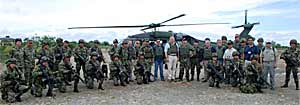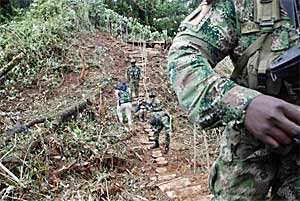Bob Arias with Gordon Radley
Bob Arias was a Peace Corps Volunteer in Colombia from 1964 to 1966. After his tour he worked for the Peace Corps for a number of years, and with various administrations. In 2001 — his last assignment, he moved on a report on Safety and Security for the Peace Corps. Then in 2003 he returned to Oregon to become the Executive Director of the CASA program. However, by 2009 he was back with the agency, first serving in Panama and Paraguay as a Crisis Corps/Peace Corps Response Volunteer, and then in Colombia where his Peace Corps service began nearly fifty years ago.
After The New York Times article by Simon Romero about Gordon Radley’s trip to the site of where his older brother had perished in Colombia was published on August 24, 2011, and reprinted on this blog, Bob dropped me a note and some additional photographs of this journey and his connection with it, and Radley’s farewell at the spot where his brother Larry and David Crozier had died, the first PCVs to lose their lives while serving in the Peace Corps.
Bob wrote:
I was the only Peace Corps Volunteer to be invited by United States Ambassador P. Michael McKinley to attend this ceremony. I had just returned to Colombia as a Peace Corps Response Volunteer, and I had only been in country a week when I was asked to represent the Peace Corps. It was for me a very emotional trip.
We flew two Black Hawks and were escorted by military helicopters across the isolated jungle mountain range in the Choco region of Colombia to the site of the crash.
We are accompanied by the current Peace Corps Country Director, George Baldino, and several members of the press. We flew over the same area where the failed DC-3 had flown on Easter Sunday morning in 1962. The crash site was no more than a postage size piece of land, cleared by the military. Because they were fearful the FARC might attack, the ceremony itself was kept brief for our safety.
Gordon took a few moments to be alone with his fallen brother . . . a moving moment for all of us. And then he began to play Beethoven’s Ode to Joy on his harmonica in tribute to and memory of Larry. It was, I think, a fitting way to bring closure to the memory of these PCVs, and of all the PCVs who have died in service over the last fifty years of the Peace Corps. I wish Sarge had been there to share it with all of us.

- Gordon Radley meets with travel party

- Travel party and military escort

- The 1962 crash site
Thanks for the post, John. It is good to keep all this nostalgia within a context of real danger and sacrifice.
I served in Peace Corps in 1962-64 and our training was in Puerto Rico. We trained in the newly established training camps in February of 1962, near Arecibo, and these camps were later named Camp Radley and Camp Crozier after the two first PCVs to lose their lives in service. Remember those training camps and the “drown-proofing” taught there by Freddy Laneou? I am so glad that the camps were given these names in remembrance.
The week following Easter 1962 was a frantic one for a group of 4 or 5 Colombia I PCVs, of which I was one, along with a number of Colombian civilians and military personnel and a handful of U.S. Air Force personnel attached to the American Embassy in Bogota, who made up the team of people who searched the Choco jungle for the downed aircraft which carried Larry Radley and David Crozier. It took a week to locate the plane which had struck the top of a cliff and slid 20 or 30 feet down the side until it lodged amongst the trees of the dense jungle. The plane was virtually swallowed up by the vegetation and could only be seen by flying directly over the point of impact. That is how an alert American Airforce pilot noticed a glint from the steel of the wreckage some seven days into the search.
Several aircraft including helicopters circled daily in crisscross search patterns and a ground team had simultaneously set out in a line westward from the runway of the Quibdo airport where the flight was headed for a landing. It was an arduous task of cutting a path through the jungle with machetes and the ground search would have taken several more days, and possibly never met with success, when the air search found its target.
The plane struck the cliff right near the top, and if it had only been a few feet higher it would have cleared the cliff safely and likely made it to the runway only a few miles straight ahead. One theory is that the pilot lost his bearing because of thick fog which shrouded the cliff. Most of the plane and its passengers and contents were buried by a small landslide caused by the imapct and the wreckage remained perched precariously in danger of falling hundreds of feet straight down to the valley below. The tail and one wing protruded from the wreckage site and that was what the pilot had seen.
We were brought in by helicopter and managed to work our way down the side of the cliff with the aid of ropes, angling in from the side, After determining that there were no survivors, the civil and military authorities in charge of the rescue operation decided that it was too dangerous for rescue workers to dig into the mud and debris encrusted on the side of the cliff to retrieve human remains. A Colombian Justice of the Peace was helicoptered in and consulted and he issued the appropriate judical orders. A Catholic priest was also helicoptered in to bless the site, making it sacred ground, in effect turning it into a cemetery. Family members were flown over, circling the site in a couple of airliners while the priest performed the holy ceremony.
Along with our two volunteer comrades, some 40 or so passengers and crew lost their lives that Easter morning.
Steve Honore
Thanks John for getting the word out, and Steve for sharing a part of history with us. I must tell you that I was very emotionally charged on the trip to the “crash” site…difficult to hold in the tears and thoughts of Crozier and Radley…and all the other “heros” that have given their lives as Peace Corps Volunteers. I was impressed with Gordon’s effort to bring closure to this time in history…Gorgeon is a real hero!
I was the Language Coordinator at Camp Radley in Puerto Rico…and an RPCV, so this was a special trip…Thanks Grodon!
In the summer of 1967 Bob Arias invited me to Puerto Rico as a Spanish teacher at Camp Radley. Bob and I had served as Peace Corps Volunteers in Colombia a country which will always be an intimate part of my life. Unfortunately I was drafted, and later served a tour in Viet Nam. I have dear memories of Puerto Rico and especially Narino, Colombia.
I read with so much interest, I went to school with David Crozier,we were in the same grade and class rooms.David was a very fine fellow.
REST IN PEACE DAVID.
Carl Ford
872 cr 8620
West Plains,Mo. 65775
I trained for the PC in Aricibo at Camp Crozier in February 67 to May 67 then departing for Honduras. That would have been Honduras Group IX. Great memories. I knew that these camps were named for PCVs but not the details which I read here for the first time.
Thanks for sharing a very difficult story
Jack Riehl
Cape May NJ and
Chapel Hill NC